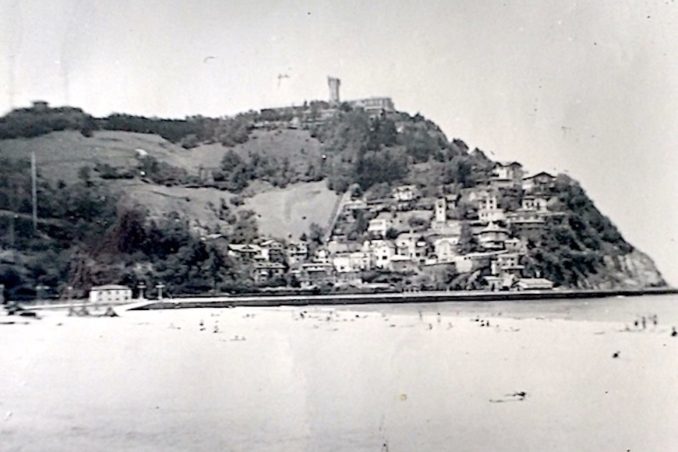
© Always Worth Saying 2022, Going Postal
From Irun on the Spanish/French border, my father and grandparents made their way south and east to San Sebastian in their heroic Ford 8. It is 1952. Famous for its magnificent double bay and beeches, in picture one (above) we can see the western beach that ends at a peninsular topped by a tower. The buildings climbing the hillside look higgledy-piggeldy but follow a winding road to the top of the hill. Although in the style of an 18th-century monument, the tower is a folly attached to the neighbouring Mercure Hotel which, all the same, provides an excellent viewpoint over both the bay, the city and the mountains beyond.
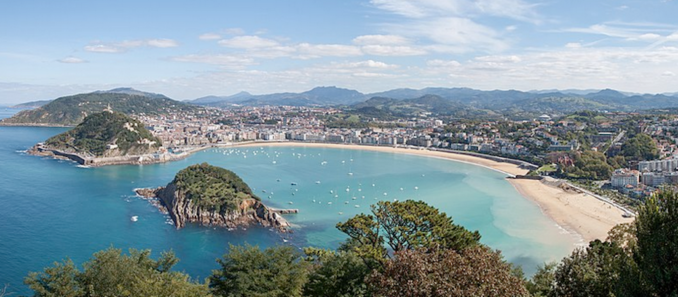
Panorama from Monte Igueldo,
Tom Page – Licence CC BY-SA 2.0

Igueldo lighthouse at San Sebastian,
Phillip Maiwald – Licence CC BY-SA 3.0
An historical tower proper sits on the other side of the hotel in the shape of the Faro Del Monte lighthouse. Although a light has been present above the cliffs of Mount Igueldo since at least the 16th century, the present building dates from 1855 and rests 400 ft above sea level. Originally running on oil, it was electrified in 1918.
The hotel and mock tower are part of an amusement park built in 1912, now a National Monumental Landmark, reachable by a twisty-road-avoiding funicular railway, visible in the old photograph above as a straight line below the tower that separates hillside villas from fields before disappearing into trees.
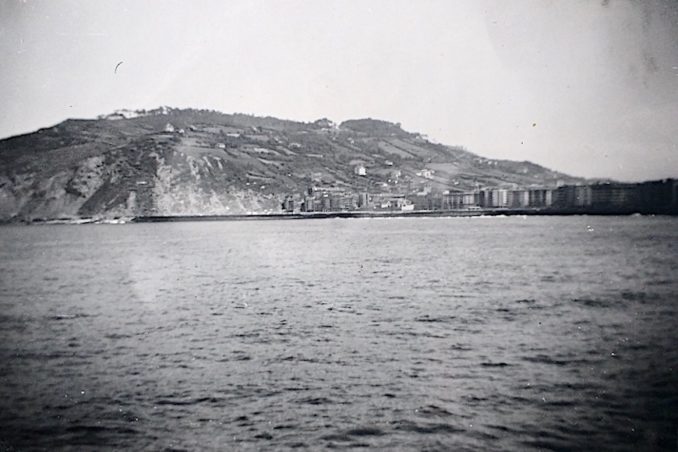
© Always Worth Saying 2022, Going Postal
Turning to the next Nostalgia Album image, we see the eastern bay, or Zurriolako (the western is known as the Bahia De la Concha). Facing eastwards, in the shadow on the right-hand side we see the Basque city’s promenade and seafront, not done justice by gloomy monochrome. Notice the tide is in, whereas the previous photo showed it out, suggesting a more than passing call to the port and coastal resort.
It was not always so peaceful. During the Spanish Civil War of 1936 to 1939, only 13 years before my family’s visit, Basque nationalists sided with the Communist Republicans. The Nationalist garrison in San Sebastian surrendered with Franco’s Nationalist General Beorlugi sent to Irun to cut off the border then divert to San Sebastian to assault the city. As early as September 1936, it was all over with Franco’s Nationalists (also known as the Falange) recapturing the municipality, half of whose population became refugees spilling over the border into France. Hundreds were killed in the fighting and hundreds more perished in the following months as a result of show trials and extra-judicial executions.
San Sebastian having been pacified, Nationalist forces headed west in the direction of Guernica, only 30 miles away, where the air raids carried out by Franco’s German and Italian allies became a foretaste of what was to come as the rest of Europe marched to war.
These days San Sebastian has a population of 288,000, roughly double the number of inhabitants seventy years ago when my father and grandparents visited. Different times. In those days, because of exchange rate and balance of payments problems, Brits were only allowed to take £25 abroad!
Halfway between then and now, and fortified by not much more than £25, your humble author would pass through, albeit by train and overnight. My memory of San Sebastian is of the football ground, visible across a railway yard during long station stops, spied through a sleeper compartment window while satisfied with fine wine (fresh from an establishment near Irun station) and further contented by good company.
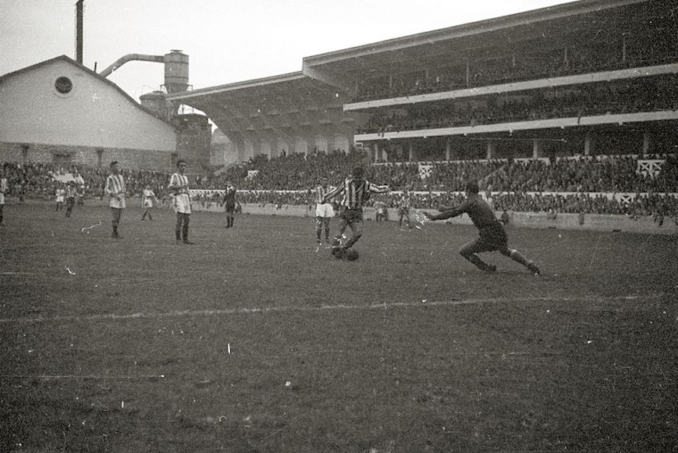
Partido de la Real Sociedad en Atotxa,
Fondo Marín-Kutxa Fototeka – Licence CC BY-SA 3.0
The Atotxa stadium reeked of old school, proper football. Squashed between railway sidings and tenements, it consisted of pitched rooves, up and over stands and a mixture of cantilevered cover and open terracing. A factory sat in one corner. Home of Real Sociedad, in my time champions of Spain, it was abandoned in 1991 when the 40,000 capacity Anoeta Stadium was built nearby. A soulless bowl of plastic seats before a running track, one yearns for the days of tightly packed crowds, close to the touchline, launching combinations of fireworks to inform the fishermen in the bay what was happening on the pitch.
Two observations about Spanish football back in the day. Firstly, when there was a shot on goal everybody went ‘woooooosh’. Secondly, there were very few travelling fans – explanation to follow.
In the modern-day, the Atotxa is a disappointing slab-sided football ground shaped block of council flats. The adjoining railway station survives and continues to understate.
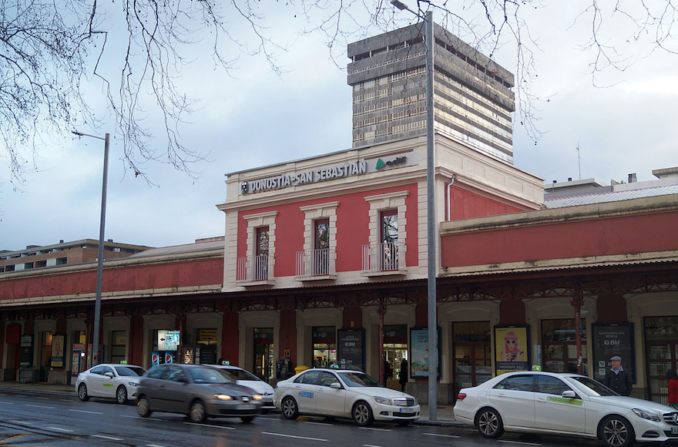
Main train station in Donostia/San Sebastian,
Philipp Hertzog – Licence CC BY-SA 2.0
From San Sebastian, my family headed south via the Puerto de Echegarate, a near 2,000 ft high pass through the Basque Mountains.

© Always Worth Saying 2022, Going Postal
The above photo was helpful captioned, however the following three were only labelled ‘Montejo Del Monte’ which I would translate as ‘mountains of hills’. One suspects the Worth-Sayings, giant GB plates proudly displayed above the back bumper of their Ford 8, asked a local where they were (in slow, shouted English) and received a description (“You’re in the mountains and hills, Amigo”) rather than a place name.
Looking at the old photos, I was surprised at how unfamiliar I am with Spain. During a life more interesting, before the country’s high-speed rail and superhighways were developed (which explains the lack of travelling fans at football matches), I zigzagged from place to place overnight by train, missing all of this.
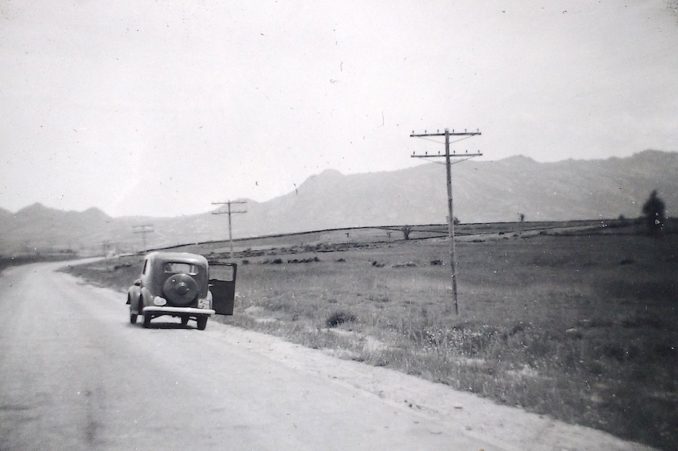
© Always Worth Saying 2022, Going Postal

© Always Worth Saying 2022, Going Postal
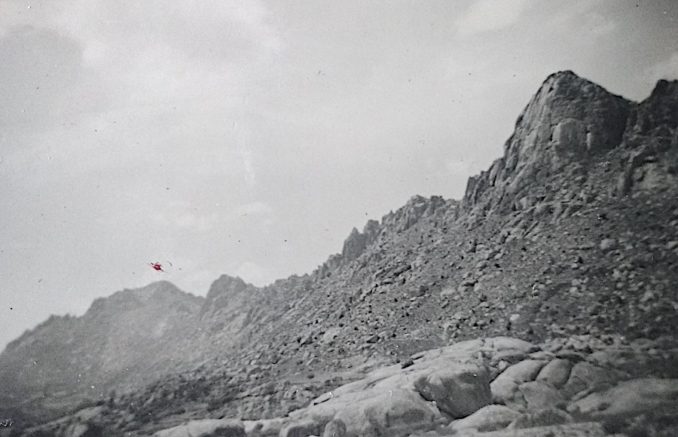
© Always Worth Saying 2022, Going Postal
Having hammered Google Maps and Street View, the best I can suggest is that the Ford 8 headed south to Alsasua and then west along what nowadays would be the A-1 towards Vitoria-Gasteiz to rejoin a more obvious route south from Burgos. I wonder if they were detouring to visit nearby Pamplona but didn’t take a picture?
Spanish roads in the 1950s weren’t great and were not meant for long-distance travel. It would have been brave to avoid Burgos and try one’s luck due south through the Sierra de Cebrollers. Although I could have tried harder, the best match I can find in Street View is westwards along the A1 / N1 from Vitoria-Gastiez to Burgos. It does look a lot cooler and greener than 70 years ago. Perhaps because of global warming?
***
Incidentally, take it from one who knows, if during your own life more interesting, good company suggests a detour to Pamplona so ‘we’ can run through the street with the bulls, she means ‘you’. And don’t think fine wine, exotic places, heat and the presence of an English travelling gentleman has elevated you to Alpha male status in her young heart. Far from it.
She knows exactly what she is doing. Not only has she planned the most painful and humiliating dumping imaginable but she already has your replacement lined up. No matter how sweet and vulnerable she appears as she peeps through her fringe while biting her upper lip and suggesting Pamplona in July, she is at least five steps ahead of you. Resist.
***
South of Burgos, the Nostalgia Album photographs are better captioned and, along what in today’s money would be the E-5 superhighway, my father and his parents passed a series of one-horse towns while heading in the direction of Madrid.
Can you tell where the final destination is yet? And why they must go there? A Puffin made an interesting suggestion in an unread comment below Nostalgia Album’s previous unread episode and, thus far, he is yet to be proved wrong.
Flatteringly, my colleague DJM assumes the family not only re-built its fortune (regular readers will recall it being lost building an iron road between nowhere to nowhere during the railway mania of the 1860s) but were well connected enough to summer at the exclusive gaming tables of Cascais, a relaxing open-top sports car drive along the coast road from Lisbon and where the Atlantic ocean meets Omah Sharif and the Aga Khan. Previously I have hinted of a rendezvous at the gaming tables, albeit in Monte Carlo, whereupon the unread comments prefered me a student selling ice cream during the summer recess. Charming.
Puffin DJM prefers us to Cascais, where a ruined gentleman may stroll by moonlight from the Hipodromo to the Citadela Pestana while pondering a jump into the marina, a second fortune unwisely having been invested on 22 red. Is he right or is he wrong? We are heading in that direction. Read on!
As an aside, while the topic is dark nights on the waterfront and the Englishman far from home, tranny alert!
No matter where the destination, en route we call at Lerma, in the province of Burgos, 110 miles due north of Madrid and 20 miles south of the city of Burgos.

© Always Worth Saying 2022, Going Postal
A small hilltop town, Lerma was the seat of 17th-century nobleman Francisco Gómez de Sandoval y Rojas, the Duke of Lerma, who built a giant Ducal palace there (not pictured above). A deeply religious man, the Duke also built six monasteries close by. Spoilt for choice, I wound estimate the above photo is of the Monasterio de la Madre de Dios, photographed from the northwest on the main road leading past the city walls. An aspect denied these days by encroachment into the countryside of modern buildings. The more impressive structure, the palace of the Duke of Lerma, lies a few narrow streets away in the direction of the magnificent bull ring.

Palacio Ducal de Lerma,
Turismo Rural Arlanza – Licence CC BY-SA 4.0
As Puffins can tell from the above photograph, the palace is constructed in the Herrerian style of symmetrical columns, windows and balconies, complemented by sober Renaissance patios. A major power during the reign of Phillip III, it is rumoured a web of secret tunnels connects the Duke’s palace to his nearby monasteries.
His descendant, Jose Larios, Duke of Lerma, was an ace pilot in the Nationalist Air Force’s Patrulla Azul squadron during the civil war. Flying Italian Flat CR 32s, ‘Blue Patrol’ claimed 294 aerial victories during the conflict, more than any of their German or Italian allies. Eleven confirmed or probable aerial victories were attributed to the Duke himself. At the time, Lerma Palace was being used as a prison.
Heading further south, we reach Aranda de Duero, the most substantial of the one-horse towns, presently with a population of over 33,000. A stop on the Irun to Madrid railway line, Aranda was of strategic importance and correspondingly saw more action during the previous hostilities.
Between 2003 and 2012 four mass graves were uncovered nearby containing the remains of 128 men and one woman, thought to have been arrested and killed by the Falange between July and October 1936. Sensitivities remain. A 2013 La Pais article revealed that Spanish Justice Minister and Prime Minister had declined invitations to attend a commemorative ceremony. DNA testing of the remains wasn’t possible because of a lack of public funds.
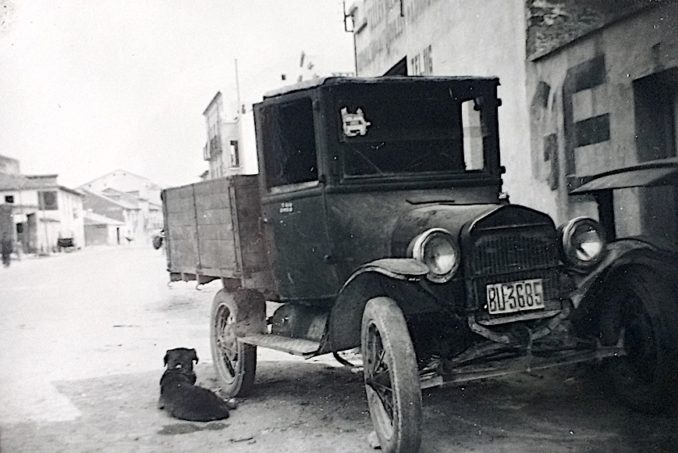
© Always Worth Saying 2022, Going Postal
For good or for bad, the days of alert hounds keeping watch on a deserted street in the shade of a Keystone Cops flatbed Ford truck are long gone. Via Street View, Aranda has swelled and is unrecognisable. A hint of a lost age emerges from the occasional remaining building. Balconies, grills and pillared streetside walkways peep shyly from amongst a present-day crush of concrete and cars.
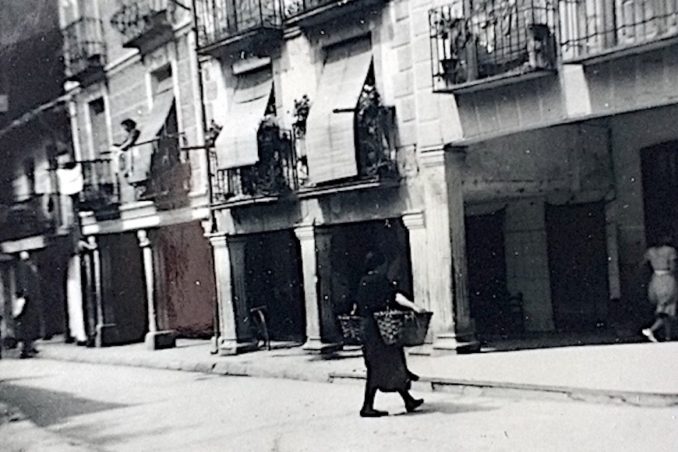
© Always Worth Saying 2022, Going Postal
In the next instalment, we shall continue the drive south through rural Spain seventy years ago. In the modern view, well off the beaten superhighway track, we make an astonishing discovery that will make even the most difficult to impress Puffin’s jaw drop in surprise.
Prepare to be amazed on your next journey with Nostalgia Album!
© Always Worth Saying 2022



